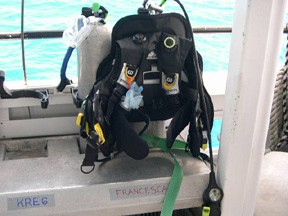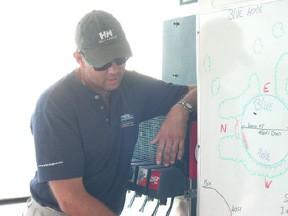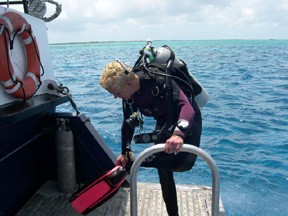Diving from a boat can offer every diver of any level something new and exciting!
When you go diving from a boat, you’ll find you get some of the best opportunities ever to see spectacular sites — amazing reefs, kelp forests, majestic pinnacles or the deepest blue holes — treasures you might not otherwise ever reach. Boat diving can frequently be much more enjoyable and much less effort than simply doing a shore dive. Whether you prefer new experiences, or just going deep – I highly recommend boat diving.
Coupled with the adventure of boat diving, comes the responsibility of understanding its unique procedures, challenges and risks. To avoid any hassles all you need to do is follow a few good rules of thumb, just like you would on any other dive. There are a wide variety of options when it comes to boat diving, from large weeklong live-aboards to smaller day charters to personal watercraft, like zodiacs. And it may sound corny but the key to a great boat dive off of a boat of any size is preparedness – you know just like the boy scouts – always be prepared!

You’ll want to plan your trip and dive accordingly and always consider the following:
Time of departure: if you make reservations on a typical day-charter dive boat, you’ll want to arrive at least 45 minutes prior to the scheduled departure so you have time to find parking, time to gear up in exposure suits on land, (so you not only have less to carry on board but also more importantly so you can avoid the not so-graceful wriggle into neoprene while clumsily bumping into 20 other bodies on a very small deck!), and time to make sure you have all of the equipment you need, neatly stowed in a single, collapsible bag. If you are going to an exotic tropical destination to spend a week on a live-aboard, make sure you book your airline flights to arrive a day early so flight delays, long customs lines, or bad weather can’t foul up your trip.
Paperwork and ID: any reputable dive boat operation will need to see your C-card and have you sign a waiver/liability form. In some cases you may need to show a second form of picture ID and if you are a newer diver, having your logbook handy for the crew’s verification of your experience level is a good thing. Many dive operators will have forms you can download from a website, so do it in advance and save yourselves and the crew some valuable time.

Be streamlined and efficient: every experienced diver knows the more streamlined they are the more efficiently they dive (i.e. they conserve air and energy and get to enjoy more!) This applies to just about every aspect of diving but especially to gear and especially on dive boats. Space is a commodity on any boat and dive boats are no exception – whether a large or small vessel – everyone will have a limited amount of storage. Start by knowing where and how to stow your gear. Not sure? Then ask a crewmember they will definitely tell you! Also, it is a good habit to set-up your scuba kit – your bcd and regulator on a designated tank station – as soon as you board, before the boat leaves the dock. This is advised because it is much, much easier to adjust your gear when you are not moving or being tossed around by sea swells or winds. After you’ve set up your kit, place any unused gear underneath the seating area near your tank station – keeping any items that must remain dry separate. I recommend bringing a small dry bag or knapsack for items that shouldn’t get wet, like fleece hats and jackets for after the dive, or your wallet or any books or snacks. Keep dive weights and weight-belts on the floor to prevent them falling on anyone’s feet, including yours!

Pay attention: when the crew and/or captain begins to describe the boat’s of safety features & equipment, the location of the head and the galley or emergency procedures for the boat listen up and stay alert. Knowing where everything is and how to handle yourself and your buddies in any given situation will make you feel more relaxed, and of course make your trip more comfortable and enjoyable. Additionally, your safety and that of others may depend on your participation, so you really should pay attention.
And then of course, no one wants to be a clod or the butt of the crew’s jokes! I work as a crew member and rescue swimmer on a dive charter boat – trust me when I say that the crew loves to amuse themselves with the incongruity of its passengers – it helps pass the time. Every boat will have their own way of doing things: specific areas for dry storage, special tables and rinse buckets for cameras only, strategic chumming stations (special locations for passengers to get sea-sick!), pay attention and keep yourself out of the ‘fair-game for merciless teasing’ category.
Take care of yourself beforehand: Get a good night’s sleep the night before, stay well hydrated, eat something solid but nothing too greasy and avoid sweets. If you are prone to seasickness, take your medication the night before AND the morning of your trip – it needs to work its way into your blood levels to work effectively. If you don’t know if you get sea sick and have never been on a live-aboard pack some ginger tablets, which you can buy at the health food store, or some motion sickness medication like Bonine, (a chewable form of meclizine); look for medications that won’t make you drowsy. Picking up something relatively inexpensive is good to have just in case. As with any medication check with your doctor or pharmacist to determine what’s best for you. Always drink plenty of water before and after your dives to stay well hydrated.

Don’t be shy and don’t be embarrassed: If you aren’t sure about how to enter the water, or which ladder to climb back onto the boat on, or you need some help with your gear never be afraid to ask, that’s what the crew is there for.
And if the maidens of mal de mer (sea sickness) visit you
on one fateful day, never be embarrassed to feed the fish (get sick, throw-up etc.). It’s not a question of "IF" it is a matter of "WHEN" because everyone gets seasick at some time in his or her life, so no one should ever be embarrassed. Plus the biggest secret is that AFTER you do a little chumming (fish feeding) you ALWAYS feel better! So don’t try to avoid it if it is happening in the moment. Another tip for avoiding the mal de mer maidens while on any boat is to stay amid ship where the boat moves less than on the far ends, and away from any diesel exhaust fumes coming from the ship’s engines or generators.
Stay warm: You will want to wear the appropriate exposure suit in the water and you will also want to have something cozy to slip into after the dive. Be aware of evaporative cooling caused by air flowing across your wet suit in between dives. Have a towel handy to dry off, and if necessary, strip off the top portion of your wet suit and warm-up in a fleece or lined-jacket and definitely a hat, to keep your core temperature up. Wearing hoods while underwater, and wooly or fuzzy hats on the boat are key as the majority of our bodies’ heat escapes from our heads.
Less is more: only bring the necessities on any boat dive trip, whether long or short. On a week long live aboard you are mostly going to be diving and sleeping, so aside from your crucial dive gear, you will really only want to bring an assortment of bathing suits, sunscreen, basic toiletries, a hat and a few pairs of shorts and t-shirts. On a day charter don’t bring extra equipment, like spare pairs of fins and such (remember, there’s not enough room!), but do bring essential boat diving equipment including visible and audible signal devices like safety dive-sausages or a whistle, and a compass is a ‘must’ to be able to navigate back to the boat.

Plan your dive and dive your plan: the dive master on the boat will give you a briefing of the site and let you know about typical conditions and what you can expect to see. If you are a less experienced diver or want an orientation of the location go on a tour with the dive master, they will be happy to show you all of the cool secrets that know about the site. Or based on the briefing, you can decide which way you are going to go and then make an agreement on air levels (psi amount) for returning with your buddy. Take a compass bearing on the direction you plan to head from the boat, so you can safely return on its reciprocal heading. If there is a current, begin your dive swimming against the current so you can end your dive with a leisurely ride back to the boat.
A great point of reference for divers is the anchor line. If you feel more comfortable with a visual cue, especially if you are a new diver or new to a site, the anchor line can help you maintain composure and gain confidence. It allows newer divers to make their descent and swim around the anchor without worrying about navigating back to the boat if they are unsure.
If you ever surface and can’t find the boat, stay calm, fully inflate your bcd and elevate your head to scan 360 degrees around you. And if need be you can use that safety sausage or whistle that you brought with you!
Bring Cash: it is always good to have some cash with you, for whatever you might need and mainly for TIPS! The crew and dive masters on any sized boat work for TIPS – that’s right folks TIPS! They are primarily compensated through tips so be courteous and be generous. They are working hard for your safety and enjoyment. At a minimum every diver should tip at least 15-20% of the cost of their trip. The crew and dive masters are providing equal, and in most cases much more service than say a waiter in a restaurant so please keep that in mind and keep the tips flowing and the bubbles blowing.
